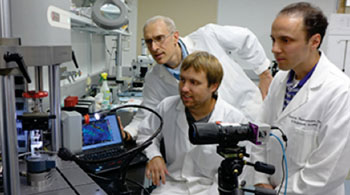Image Analysis Algorithms Devised to Find Weak Spots in Muscles, Tendons, and Bones prone to Tearing, Breaking
By MedImaging International staff writers
Posted on 09 Sep 2014
Researchers have developed algorithms to detect weak spots in muscles, tendons, and bones predisposed to tearing or breaking. The technology, which needs to be further refined before it is used in patients, may soon help target minor strains and tiny injuries in the body’s tissues long before greater problems occur.Posted on 09 Sep 2014
The research was published online August 27, 2014, in the journal of the Royal Society Interface, which publishes research at the nexus of the physical and life sciences. “Tendons are constantly stretching as muscles pull on them, and bones also bend or compress as we carry out everyday activities,” said senior investigator Stavros Thomopoulos, PhD, professor of orthopedic surgery at Washington University in St. Louis (MO, USA). “Small cracks or tears can result from these loads and lead to major injuries. Understanding how these tears and cracks develop over time therefore is important for diagnosing and tracking injuries.”

Image: From left, Guy Genin, PhD, John Boyle and Stavros Thomopoulos, PhD, watch as a sample is exposed to stress and force. They have developed algorithms that may lead to the ability to identify weak spots in tendons, muscles and bones (Photo courtesy of Washington University in St. Louis).
Dr. Thomopoulos and his colleagues developed a strategy to visualize and even predict spots where tissues are weakened. To accomplish this, they pulled tissues and monitored what occurred as their shapes changed or became distorted. The study’s first author, John J. Boyle, a graduate student in biomedical engineering, combined mechanical engineering basics with image-analysis techniques to create the algorithms, which were tested in different materials and in animal models. “If you imagine stretching Silly Putty or a swimming cap with a picture on it, as you pull, the picture becomes distorted,” Dr. Boyle said. “This allows us to track how the material responds to an external force.”
In one of the experiments described in the paper, Dr. Boyle sprayed a pattern of dots on plastic wrap, stretched it and tracked the dots. “As you pull and stretch the plastic wrap, eventually tears begin to emerge,” he explained. “The new algorithm allowed us to find the places where the tears were beginning to form and to track them as they extended. Older algorithms are not as good at finding and tracking localized strains as the material stretches.”
One of the two new algorithms is 1,000 times more accurate than older approaches for quantifying very large stretches near tiny cracks and tears, the research showed. And a second algorithm has the ability to predict where cracks and failures are likely to form. “This extra accuracy is critical for quantifying large strains,” said Guy Genin, PhD, professor of mechanical engineering and co-senior investigator on the study.”
Commercial algorithms that estimate strain frequently are much less sensitive, and they are prone to identifying noise that can arise from the algorithm itself instead of from the substance being examined. The new algorithms can differentiate the noise from true regions of large strains.”
Dr. Thomopoulos, who also is a professor of biomedical engineering and of mechanical engineering, works with Dr. Genin to study the shoulder’s rotator cuff, a group of tendons and muscles that connect the upper arm to the shoulder blade. They are setting out to determine why some surgeries to repair rotator cuff injuries eventually fail. Their goal is to increase the chances that the tissue in the shoulder will heal following surgery, and they think the new algorithms could help them get closer to that objective. How soon the new algorithms could be used in patients depends on getting clearer images of the body’s tissues. Current imaging techniques, such as magnetic resonance imaging (MRI) and ultrasound do not have the required clarity and resolution.
Dr. Genin also explained that although the objective of the current study is to better determine how forces at work on human tissue cause injury and stress, the algorithms also could help engineers identify vulnerable areas of buildings and other structures. Our muscles and bones, he said, are influenced by the same strains that affect those structures. “Whether it’s a bridge or a tendon, it’s vital to understand the ways that physical forces cause structures and tissues to deform so that we can identify the onset of failures and eventually predict them,” he said.
In the long term, the investigators want to use the algorithms to prevent further injuries following surgery to repair, shoulders, knees, and other tissues. They also reported that it may be possible in the future to predict problems before they occur.
The scientists, who applied for a provisional patent earlier in 2014, hope the algorithms will be useful to researchers in the medical and engineering fields.
Related Links:
Washington University in St. Louis










 Guided Devices.jpg)



